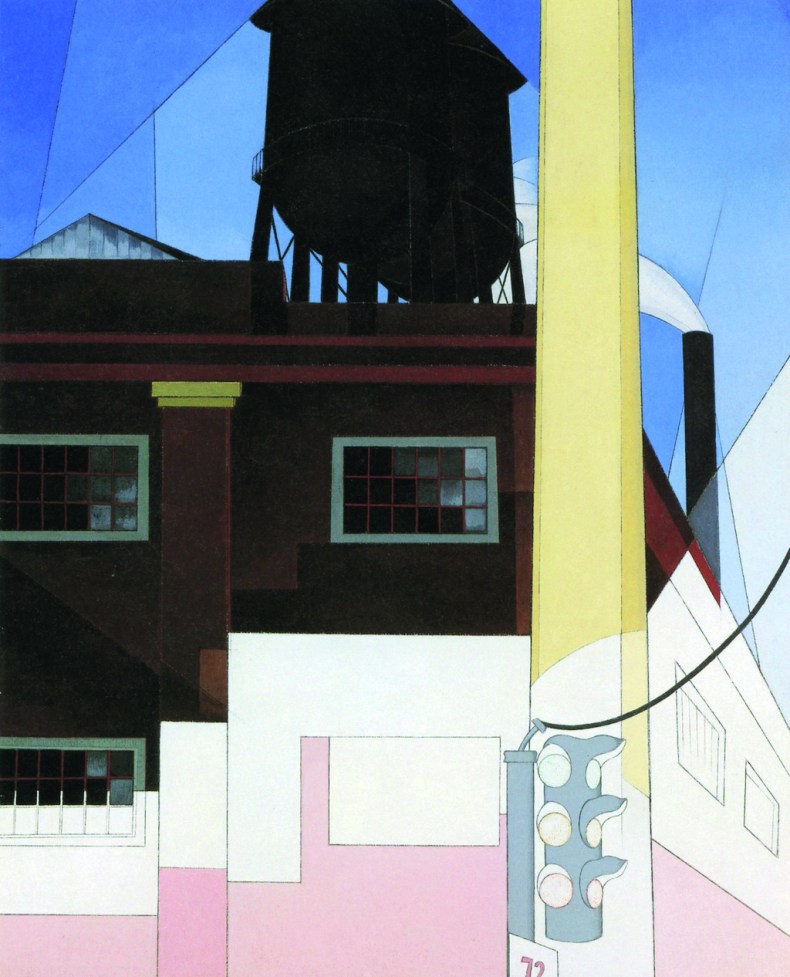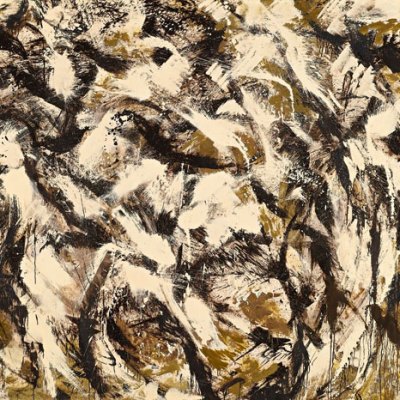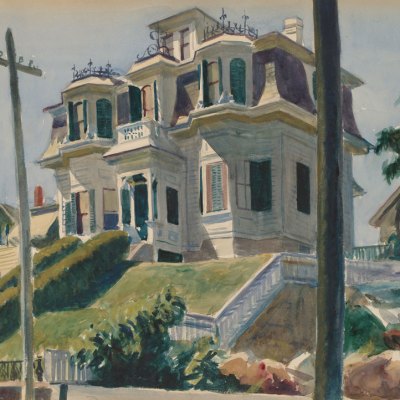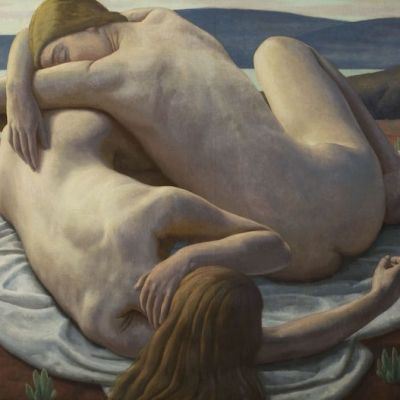The shirt worn by the farmer in Grant Wood’s American Gothic has been washed and washed so often the cotton is transparent. Hang it on a line and you could watch the clouds through it. You may have seen the painting reproduced and parodied, but until you’ve seen it in the flesh – its inclusion in the Royal Academy’s ‘America after the Fall: Painting in the 1930s’ (until 4 June) marks a rare trip from the Art Institute of Chicago (where the exhibition opened in June 2016 before travelling to the Musée de l’Orangerie and now London) – you miss the texture of it. His shirt like a second skin; the rickrack trim of her dress fraying where it rubs under her arm. The waxy sallowness of his cheeks; the weathering of the whitewash of the house.
American Gothic (1930), Grant Wood. The Art Institute of Chicago

At the Royal Academy, this exhibition feels like a prequel of sorts to last year’s triumphant ‘Abstract Expressionism’, which filled the main galleries with Rothkos, Pollocks and de Koonings from the 1940s and ’50s. Here, in the Sackler galleries, is the jittery, hard-up decade that came before. Through 53 paintings, organised thematically to show bright-light cities, prairie pastorals, the churn of industry, and nostalgia for American history, the exhibition charts the anxieties of the decade between the Wall Street Crash of 1929 and the United States’ entry into the Second World War in December 1941.
Wood’s couple are the left-behinds. Grandparents of the Midwesterners who in the most recent American election voted for Donald Trump. Wood had seen the white Gothic Revival house while driving through Eldon, Iowa. ‘This gave me an idea,’ he said. ‘That idea was to find two people who by their severely straight-laced characters would fit into such a home.’ Residents, then, of the forgotten states, the farming states. The flyover fields between the two coasts, no interest to Berkeley and Brooklyn.
Already in 1930, such families were relics. The 1920 census had revealed that for the first time the majority of the nation’s population lived in towns. The jobs were in Chicago, Cleveland and Detroit, making steel, trains and automobiles. (Detroit was the future once.) In 1915 it had taken Ford 14 hours to make a car; 10 years later, a new Ford came off the factory line every 10 seconds. By 1932, one in six farmers owned a tractor. What chance for Mr Gothic, still holding on to his pitchfork?
It’s too late now for him to move to the big city, to order burgers at Edward Hopper diners, take up with a Jean Harlow blonde, and start listening to the Black Bottom and Harlem jazz. He could no more give up his farm than dance the Chicken Shake Shuffle. It’s part of him. The stripes of his shirt echo the board-and-batten facing of the house; the print of her dress matches the curtains in the upstairs window.
Wood was on the farmers’ side. He, too, wore bib overalls. In 1935 he wrote an essay called ‘Revolt against the City’, in praise of men with farms and barns in the endless Midwest. He admired the independence of the yeoman farmer, his self-reliance, his conservatism. His farming couple may not actually have existed – the artist’s dentist and sister, who in real life had hair set in fashionable Marcel waves, modelled for it – but they’re emblematic of the old survivors: farmers who loved their land and fatherland.
The title of the exhibition might have been America after the Crash, or the American Depression, or the Dustbowl Thirties. But it is deliberately ‘After the Fall’, to suggest a rural Eden before the stock-market crash of 1929, the droughts, and years of mass unemployment. In 1932, half of African Americans were out of work. Whites called for blacks to be fired from their jobs. Lynchings increased four-fold between 1932 and 1933. The Ku Klux Klan drew new recruits.
The show is low on beauty – drab and desolate are the themes – but excels as a portrait of the times. The gallery texts and catalogue draw parallels between the painting of the period and its literature (the economic migrants of John Steinbeck, the Midwestern cities of Sinclair Lewis’s Babbitt and the old Great Plains families of Willa Cather’s O Pioneers!), the music of the Jazz Age dance halls, and the movie theatres where an out-of-work factory hand could keep warm and admire Claudette Colbert’s ankles for 20 cents. A contrast is set up between the Regionalism of artists such as Wood and Thomas Hart Benton, who painted the wheat-harvest states in a traditionally figurative style, and the modernism of urban artists, in its various forms: Precisionism, Park Avenue Cubism, Harlem Renaissance.
…And the Home of the Brave (1931), Charles Demuth. Art Institute of Chicago

So we see parched field workers drinking their water ration from a pail in Benton’s moving Cotton Pickers (1945), and are drawn to the high-heeled cinema usherette in Edward Hopper’s New York Movie (1939), bored by a film she’s seen before. Charles Demuth gives us a corner of Chicago’s Bayuk Brothers Cigar Company in …And the Home of the Brave (1931), a title that rolls its eyes at the Star-Spangled Banner. Land of the free? Home of the brave? This Chicago is a land of traffic lights, water towers and factory chimneys.
Doris Lee’s Thanksgiving (1935) invites us into a mom-and-apple-pie kitchen with smiling babies and a dog warming its back under the range. Compare the bustle in that Illinois homestead with the New York nightclub in Philip Evergood’s Dance Marathon (1934) where spent, exhausted couples collapse against each other. The women wear tight trousers, men partner men, and the central couple are mixed race: she a blonde wearing too much make-up, he Hispanic with improbable biceps.
You can imagine what Grant Wood’s three thin-lipped spinsters in Daughters of Revolution (1932) would think of such a crowd. The fingers of the daughter in the middle, daintily holding a willow-pattern cup, are exquisitely painted. Wood invests hands with great character. His farmer is gripping the pitchfork as if his life depends on it. One hopes, for the sake of his grandchildren, that the farm is sitting on a deep reserve of shale gas.
From the April 2017 issue of Apollo. Preview and subscribe here.



